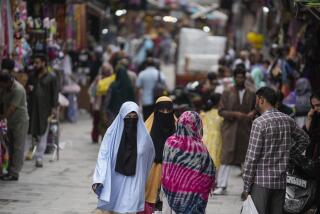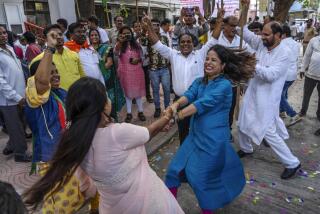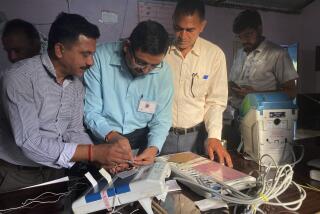ASIA : Curtain Rising on the Greatest Vote on Earth
- Share via
NEW DELHI — It’s democracy’s greatest show on Earth, and it opens this weekend.
From the Himalayan slopes to the steamy coconut groves by the Arabian Sea, Indians will be going to the polls.
Millions will walk, some for hours in the hot sun, for the privilege of casting their ballots. Others will journey in canoes or on the swaying backs of elephants to exercise their civic duty.
And once again, the catch phrase “the world’s greatest democracy” will assume its full meaning.
Sure, Russia, the United States, Israel and other countries are also holding elections this year. But for sheer scale, they don’t come close to India, where more than 14,000 candidates are vying for the 543 seats up for grabs in the Lok Sabha, the lower house of Parliament.
The numbers involved are staggering: 590 million eligible voters, 820,000 polling booths, 5 million poll watchers and ballot counters, and 2 million police and paramilitary troops to keep order.
“This will be the biggest possible election anyone in the world has ever run,” said Chief Election Commissioner T. N. Seshan, who estimates the cost of conducting the event at $120 million.
Some Himalayan polling stations are located 19,000 feet above sea level, and Seshan’s subordinates must borrow Indian army helicopters to reach them.
In remote Arunachal Pradesh along the border with Tibet, one polling station serves a grand total of three voters, Seshan said. The regulation five poll workers assigned to that remote locale will have to hike for 72 hours with the ballot box and indelible ink to mark voters’ fingers.
More than 8,000 tons of paper--1,000 just for the northern state of Uttar Pradesh, home to 100 million voters--were needed to print ballots.
Lok Sabha hopefuls include a cricket player, movie actors and Phoolan Devi, the celebrated “Bandit Queen” once imprisoned for killing 22 high-caste villagers.
In the Modakuruchi district of southern Tamil Nadu, one of the Indian states simultaneously holding elections for its assembly, a record 1,033 candidates have made the ballot, which is being printed in book form to hold all the names.
The three-phase election ends May 30, but the outcome is expected to be known by May 12. The results will decide whether the Congress (I) government of Prime Minister P. V. Narasimha Rao can survive.
With only days left before voting begins, polls and pundits indicate that Congress (I) Party will not win an outright majority in the Lok Sabha. An intense round of horse-trading is expected once results become known.
V. P. Singh, a former prime minister, has predicted that the three major political groups--Congress, the Hindu nationalist Bharatiya Janata Party and the left-leaning National Front/Leftist Front--will each get 130 to 180 seats.
The Indian government has also taken a gamble by extending the election to the disputed state of Jammu and Kashmir in the far north, which has been under direct rule from New Delhi since 1990, following the outbreak of a separatist rebellion.
This spring, Kashmiris will have the opportunity to vote for the first time since 1989. Kashmiri activists denounce the exercise as a farce, but Seshan rejects their criticisms.
Like the vast majority of Indians, Seshan also voices great pride at his country’s way of transferring power--peacefully and democratically.
“Nobody in the world has anything comparable,” he said.
More to Read
Sign up for Essential California
The most important California stories and recommendations in your inbox every morning.
You may occasionally receive promotional content from the Los Angeles Times.













